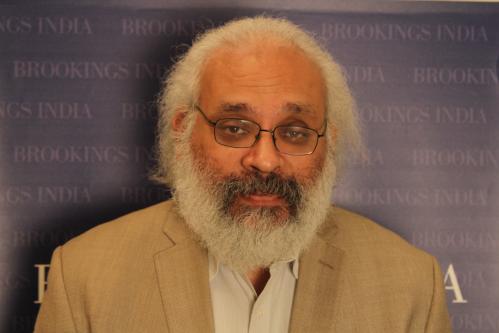Content from the Brookings Institution India Center is now archived. After seven years of an impactful partnership, as of September 11, 2020, Brookings India is now the Centre for Social and Economic Progress, an independent public policy institution based in India.
In its essence, governance is about alignment. Multiple groups, each with its own menu of interests, some coherently articulated and others not, demand recognition and satisfaction from the government. Areas of commonality need to be found and reinforced, while differences need to be reconciled, not by the domination of one group over another, but by the power of persuasion. There is a greater “good” to be achieved by compromise and the costs incurred by each group now will be more than compensated for by gains in the future.
In this context, a “governance crisis” reflects a breakdown in the government’s ability to achieve and sustain alignment. Stakeholder groups with bargaining power become more and more assertive as to their interests because the message about the greater good and future gains loses credibility. In these circumstances, the government is compelled to pander to the interests of the more powerful groups at the time, inevitably at the expense of others.
Many people would argue that India is facing a governance crisis today. Virtually everybody would agree with the proposition that the system is under serious stress. Crisis or not, there is no doubt that the next government is going to have to do a serious repair job to get the critical alignment function working again. I find it useful to think about this process in terms of four broad interfaces between interest groups. Here are some examples of the alignment issues involved in each interface.
Within government: All significant policy measures require effective co-ordination between different ministries and departments. One might think that, being part of the same structure, they would all be bound by some commitment to the larger goals of policy. One would be wrong. Every ministry functions as a representative of the interest group that it has jurisdiction over. This is not necessarily a bad thing if the alignment process is working effectively. Everybody has the reassurance that their concerns are being adequately projected. The challenge is to ensure that the alignment mechanism is working. We have so many processes in place that are supposed to perform this function – groups of ministers, some of which are empowered to take final decisions, Cabinet committees and, finally, the Cabinet itself. The policy paralysis critique is essentially that none of these is working with the efficiency necessary, with the result that no significant policy measures make it from intent to implementation.
The point is that, whatever the policy priorities and agenda of the next government may be, they will remain theoretical unless the constraint of interministerial co-ordination is dealt with. There are many issues relevant here, but let me highlight one essential requirement for this to happen – an inviolable closure rule. A proposal should be treated as acceptable if a request for views is not responded to within a fixed time frame – a direct application of the “speak now or forever hold your peace” principle.
Between Centre and states: I recently interacted with a group of MLAs from several states, who were participating in a programme on state finances organised by the Parliamentary Research Service (PRS). Technical issues on deficits, transfers and so on over and done with, the discussion turned to centrally sponsored schemes. I had a few slides on independent reviews of some flagship schemes. Before I got to them, I asked the participants what they thought of these programmes. I expected a blanket condemnation, but, instead, I got a very balanced set of critiques, providing reasons for why some of them were working reasonably well and others failing miserably. When I put up the slides, they were struck by the similarities between their assessments and those of the reviews.
The main point that many of the MLAs made was the difficulty that local conditions posed in implementing programmes that were basically designed by the Centre. The intention expressed in the interim Budget to transfer greater responsibility to the states for design and implementation is a welcome response to this general concern. However, capacity to design, let alone implement effective programmes in different conditions, may currently not exist at the state level. The move towards decentralisation needs to be supported by creating the right kinds of knowledge and capacity generation and sharing mechanisms. Having been associated with the consultancy business for some time, I was struck by the fact that in most assignments for state governments, a lot of person hours were spent trying to find out what other states were doing. Surely, this should be public knowledge and the central government can create and manage platforms on which it is effectively shared.
Between public and private sectors: The reforms of the 1990s fundamentally redefined the relationship between the public and private sectors, to the huge benefit of the economy. However, a more recent phase of this relationship, the pubic-private partnership (PPP) strategy for infrastructure development, has clearly hit some severe roadblocks. The cost and revenue assumptions of many projects have been completely violated, leading to enormous financial stress, which is spilling over into the banking sector as well.
One way of looking at the problem is that the PPP framework resulted in an unsustainable distribution of risks between the partners. The question is whether any arrangement that redistributes risks to the public sector denies us the potential efficiency gains in project execution and management that the private partners were expected to bring in. But, whatever the diagnosis, there is no question that the infrastructure gap will only widen without a solution; no infrastructure, no growth.
Between state and citizen: Examples of alignment failures abound. One important instance is the persistent increase in rice prices over the past year and a half – around 15 per cent per year – despite the massive stocks in the possession of government. Sale of stocks would bring down prices and presumably be welcomed by consumers. But, of course, this would upset farmers. Given that inflation is one of the top two issues of concern – the other being corruption – listed by citizens in responses to voter surveys, one would think that bringing rice prices down would be a politically prudent act. Apparently not.
Some alignment issues could probably be resolved by simply doing things differently within the existing system. Others will require reforming the system itself. The effort required and the risks of doing this are high. But the rewards will be high and, most importantly, so will the costs of not doing so.
This column first appeared in the Business Standard, on February 23, 2014. The views are of the author(s).








Commentary
Op-edRealigning Governance
February 26, 2014